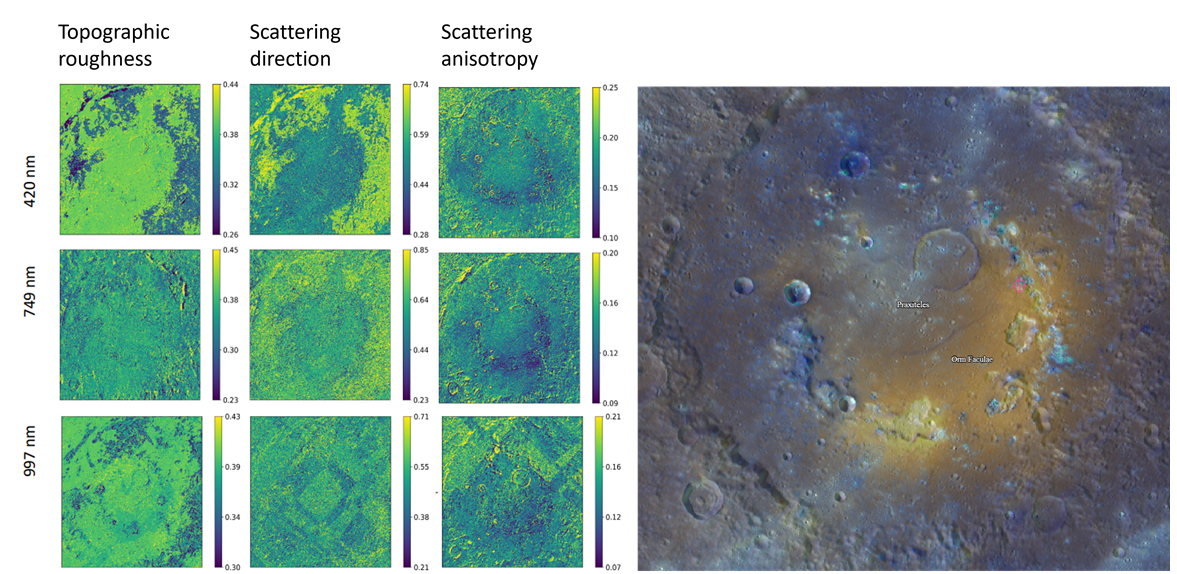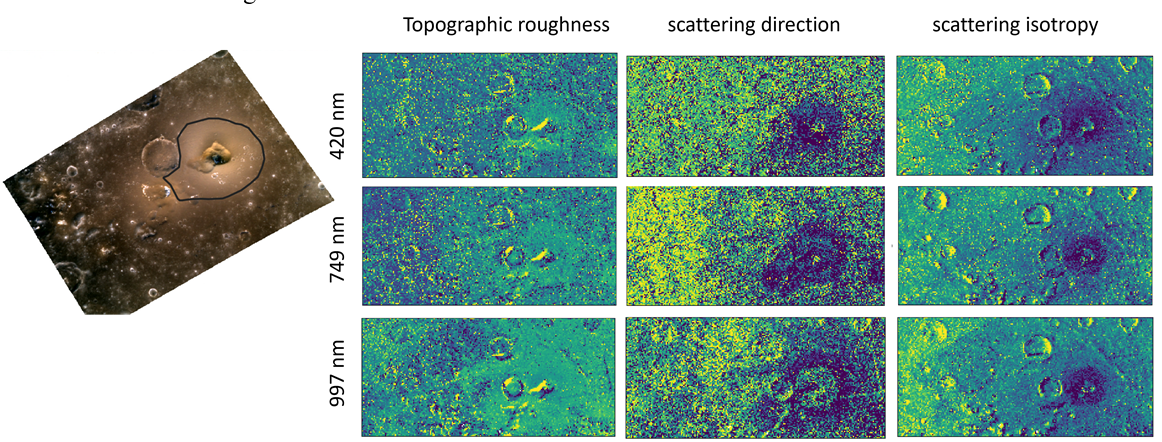- 1INAF-Osservatorio Astronomico di Padova, Padova, Italy (giovanni.munaretto@inaf.it)
- 2Istituto di Astrofisica e Planetologia Spaziali (INAF-IAPS), Italy.
- 3Planetary Science Institute, Arizona, USA
- 4Department of Geological Sciences, University of Padova, Padova, Italy
Introduction. Photometric modelling is a technique that investigates the variations in light reflection by a surface upon different viewing and illumination geometries. This technique is widely used in planetary photometry [1-5] and allows to investigate the physical properties, such as surface texture, albedo and roughness of the reflecting materials at microscopic (i.e.: particle-size) scales. Past applications to Mercury were aimed at producing global scale monochrome and colour basemaps [5]. Until recently, this method has never been used at local scales to analyze surface features, such as hollows, and characterize their physical properties. In [7], we investigated the scattering properties of hollows located at the Tyagaraja and Canova craters on Mercury through the photometric modelling of overlapping multi-angular MDIS/WAC observations, based on the inversion of the Hapke and Kasalaainen-Shkuratov set of models [14-17]. The analysis allowed to derive dedicated photometric corrections for hollows, allowing future more accurate spectrophotometric analyses. The estimated hollows Hapke parameters also provided new evidence for volatile-release as their forming mechanism. This abstract shows new applications of this methodology to pyroclastic deposits, with the aim of better understanding their microphysical properties.
Methods. We analyze multi-wavelength and multi-angular MDIS/WAC observations of pyroclastic deposits. We consider the Orm Faculae, located inside the Praxiletes Crater (27.1°N, -60.3°E), the pyroclastic vent in Tyagaraja crater, Agwo Facula and the vent in Picasso crater. For all locations, we apply the approach described in [13].We select all MDIS/WAC observations at each location, having phase angles from 30° to more than 90°, and project them on the USGS global DEM. For Praxiteles, we mosaicked the global USGS DEM of Mercury with local DTMs from [18]. All the observations and the DTMs were resampled at 665 m/px for Praxiteles and Tyagaraja, and 1330 m/px for the other locations. First, we define a grid with the resolution of the DTM. For each point of the grid we collected the flux from all the available WAC observations, the incidence, emission, phase and azimuth angles and fit the resulting dataset with the Hapke model. This procedure was done for each MDIS band, providing in a set of wavelength-dependent Hapke parameter maps.
Results
Praxiletes crater. In Fig. (1) we show the Hapke parameters maps for Praxiletes crater. In particular, we find that the pyroclastic deposits (yellowish in the colour compiste) are correlated with lower anisotropy parameter regions than the surrounding material, meaning that light from these particles is reflected in a less isotropic way. The crater floor is also characterized by a lower value of the scattering direction parameter with respect to the outer terrains, implying a more forward scattering behaviour. A trend is also observed on the topographic roughness, which suggest a rougher crater floor than the surroundings.
Agwo faculae. In Fig (2) we show the Hapke parameter maps for Agwo facula. The extent of the facula is visually correlated with specific Hapke parameters, i.e., higher roughness than the surroundings, as well as lower anisotropy and scattering direction parameter, implying a more forward scattering behaviour.
Tyagaraja and Picasso crater parameter maps will be presented at the conference.
Discussion. We applied the photometric modelling approach previously designed for hollows to the pyroclastic deposits of Praxiletes crater, Agwo facula, Tyagaraja and Picasso craters. We derived Hapke parameter maps for all these location in multiple bands. Our results shows preliminary correlations between geological features (facula, crater floor), and scattering properties (forward vs backward scattering, roughness). Their integration with the geological maps of these locations will provide a more consistent framework to interpret the microscopic properties of the regolith grains composing the pyroclastic deposits, that will be presented at the conference.

Figure 1 Hapke parameters (left) of Praxiletes crater at selected wavelengths. A colour composite image of the crater is shown on the right.

Figure 2 Left : RGB composite showing Agwo facula. Right : Hapke parameter maps.
Acnowledgements: This study has been supported by the Italian Space Agency (ASI) through the ASI-INAF agreement no. 2020-17-HH.0. This research was supported by the International Space Science Institute (ISSI) in Bern, through ISSI International Team project #552.
References: [1] McEwen, 1991, Icarus, 92, 298-311; [2] Jehl et al., 2008, Icarus, 197, 403-428; [3] Fernando et al., 2013, J. Geophys. Res. Planets, 118, 534-559; [4] Sato et al., 2014, J. Geophys. Res. (Planets), 119, 1775-1805; [5] Domingue et al., 2016, Icarus, 268, 172-203, [6]). [7] Munaretto et al., (2023) [14] Hapke, 1993. Theory of reflectance and emittance spectroscopy; [15] Kaasalainen et al., 2001, 153, 1, 37-51 [16] Shkuratov et al., 2011, 218,1, 525-533 [17] Schröder et al., 2013, 85, 198-213. [18] Fasset et al., 2016, PSS, 134, 19-28
How to cite: Munaretto, G., Galiano, A., Domingue, D., Tullo, A., Bertoli, S., Tusberti, F., Re, C., Cremonese, G., Lucchetti, A., Pajola, M., Simioni, E., and Massironi, M.: Spectrophotometric modelling of MESSENGER/MDIS multiangular observations reveals physical properties of Mercury’s pyroclastic deposits, Europlanet Science Congress 2024, Berlin, Germany, 8–13 Sep 2024, EPSC2024-762, https://doi.org/10.5194/epsc2024-762, 2024.